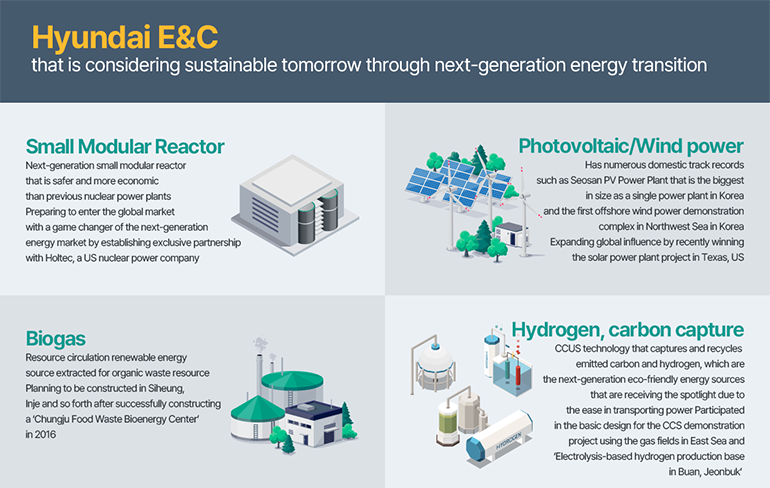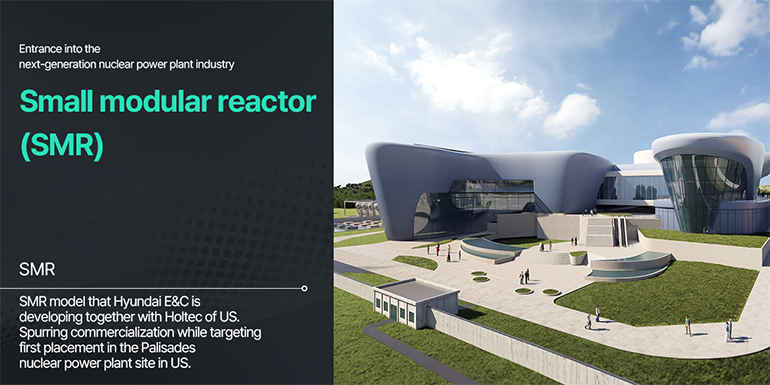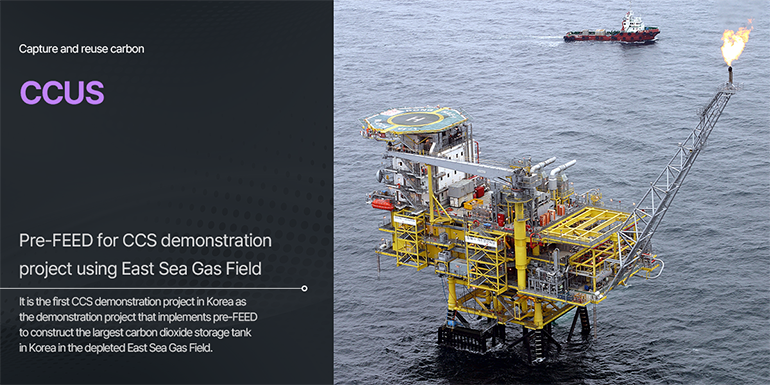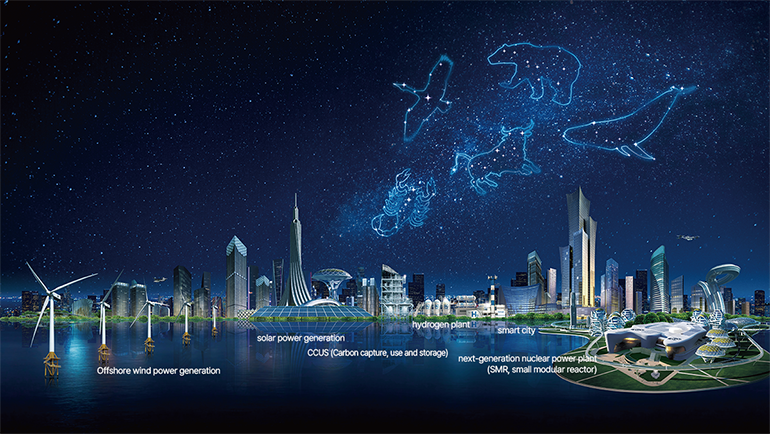
Latest News
- Hyundai E&C applies smart EV charging solution to apartment buildings for the first time
- Hyundai E&C wins one of the world’s top three design awards for four consecutive years
- Hyundai E&C Signs PPA for Solar Renewables with Glennmont D&D Solar Holdings
- Hyundai E&C to Embark on UK SMR Project forging Korea-US-UK Technology Alliance
- Hyundai E&C Consolidates Leading Position in Concrete Safety and Quality Technology
[60-year energy history of Hyundai E&C ②] From next-generation future energy to power trading
![[60-year energy history of Hyundai E&C ②] From next-generation future energy to power trading [60-year energy history of Hyundai E&C ②] From next-generation future energy to power trading Hyundai E&C is thinking beyond expansion of insufficient energy and is standing at the forefront of clean energy transition centering on low carbon while considering the future of earth based on its technological capability and experience of the energy industry that has been accumulated for a long time.](/FileContents/EditorImg/20231218/1_770.png)
Thinking about the future of earth with next-generation energy
Abundant electricity brought about a new paradigm to humanity. However, power generation centered on fossil fuel led to environment issues caused by emission of carbon dioxide. Against this backdrop, Hyundai E&C is thinking beyond expansion of insufficient energy and is standing at the forefront of clean energy transition without carbon while considering the future of earth.

① SMR that will prove the capability of K-nuclear power plants even in next-generation power plants
There are many benefits to atomic energy that uses nuclear fission such as low fuel cost, large amount of power production, reduction of greenhouse gas and so forth, but there are also concerns. Hyundai E&C that stands tall as the representative of K-nuclear power plant through the construction of nuclear power plants at home and abroad for 50 years is standing out by entering into the ‘small modular reactor (SMR)’ business that complements the large-scale nuclear power plants based on the technological capability that it has accumulated until now.

SMR is a small nuclear reactor with power output that is equivalent to 300MW or less, and its characteristic is that pressurizer, steam generator and nuclear reactor would be inserted into a single container. Since it has a unified structure, it is excellent in terms of securing land, safety and economics as compared to existing nuclear power plants. Hyundai E&C entered into an exclusive contract with a US nuclear power company, Holtec International, since 2021, to jointly develop SMR and enter into the business, and is rapidly showing progress such as being the first Korean construction company to start commercializing design in US. Hyundai E&C and Holtec are carrying out the business with a target of construct the first SMR in the Palisades nuclear power plant site in US, and it is standing tall as the representative model of international nuclear power plant projects by carrying out activities such as reviewing joint entrance into more than 20 countries including those in Europe, with US as a start.
② First and the largest PV, Offshore wind power project of Hyundai E&C in Korea
![Photovoltaic Proved in-house construction capability Photovoltaic Seosan Solar PV Power Plant [2018] Installed 185,724 sheets of solar modules with a capacity of 350W as the PV power generation facility that was established in an idle site with an area of 993,480m2 (Approximately 300,000 pyeong) that Hyundai E&C secured in the 1980s through the land reclamation project.](/FileContents/EditorImg/20231218/10_770.png)
Hyundai E&C was also early in entering the power generation project that used sustainable natural energy. In particular, PV power generation started in Seosan, Chungnam, land that symbolizes the challenges that Hyundai E&C took on. Hyundai E&C constructed the largest solar PV power plant in Korea with 130MWh energy storage device and 65MW power generation facility in 993,480㎡ (Approximately 300,000 pyeong) idle land among 15,900 ha land that it secured through the Seosan land reclamation project carried out in the 1980s.
Based on such an experience, Hyundai E&C entered into joint development for the US solar power project by constructing a private-public partnership with Korea Midland Power (KOMIPO) and Korean Overseas Infrastructure & Urban Development Corporation (KIND), and it is planning to strengthen competitiveness in winning orders for the US renewable energy power generation projects, where solar power generation takes a big portion. Hyundai E&C is already cooperating with KIND in the development project to construct a 459MW solar power generation facility in the central region of Texas, US. Now it is one step closer as the representative player in next-generation renewable energy.
![Offshore wind power Leading position with the largest size in Korea Offshore wind power [Planning to complete construction in 2024] Jeju-Hallim Offshore Wind Farm Largest wind farm that is being constructed in the Hallym-myeon region of Jeju Island. Boasts of 100MW with the installation of 18 5.56MW wind power generator](/FileContents/EditorImg/20231218/11_770.png)
Another representative player in addition to solar power is wind power. Hyundai E&C is building a leading position in domestic offshore wind power project that generates electricity by rotating a large power generator with the kinetic energy of strong sea breeze. Hyundai E&C came to be in charge of constructing the Northwest Sea Offshore Wind Power (60MW) Complex, which is the initial demonstration project for offshore wind power that was attempted for the first time in Korea to install 20 3MW offshore wind power generators. With this as the foundation, Hyundai E&C is also spurring the successful construction of Jeju-Hallim Offshore Wind Farm, which is the largest in Korea. The power generation capacity of one wind power generator in Jeju-Hallim Offshore Wind Farm is 5.56MW, and it is approximately 1.9 times stronger than the one in Northwest Sea (3MW). Hyundai E&C is in charge of the overall project from the discovery of the project to finances and EPC (design, construction and procurement), and Hyundai E&C is expected to play a huge role in expanding the penetration of offshore wind power in Korea through ‘Hyundai Frontier’, the only installation vessel in Korea that is dedicated to offshore wind power.
③ New energy that is born out of waste, Hyundai E&C’s biogas project
![Biogas Energy born out of waste Biogas Chungju Food Waste Bioenergy Center [2016] Largest korean-specific demonstration system that turns waste resource into energy which boasts of organic degradation rate of 90% or more](/FileContents/EditorImg/20231218/12_770.png)
One area that Hyundai E&C is focusing on to efficiently use the limited amount of resource is organic waste resource. Biogas is a type of energy that is generated by microorganisms while treating organic waste resource such as food waste, livestock manure and sewage residues. Since biogas can produce more than 97% biomethane when impurities and carbon dioxide are removed, it is receiving the spotlight as a resource circulation energy. Hyundai E&C already secured source technology by starting research and development on biogas since 2008, and in 2016, it succeeded in commercialization by completing the construction of Chungju Food Waste Bioenergy Center. Currently, ‘Siheung Clean Energy Center’ that will produce biogas by integrating a variety of organic waste resource is planning to finish construction in 2024, and in May, a working-level partnership was entered into with Ministry of Environment and Inje-gun on the construction of an integrated bio gas production facility.
④ Targeting hydrogen economy that the whole world is focusing on, Hydrogen and carbon capture project
Power that is generated through the sunlight and wind is sustainable renewable energy for sure, but there is the variable of weather. There would be surplus power if more power is generated than required in a good weather condition, but on the contrary, if the weather condition is bad, power generation could be difficult and lead to an unpredictable situation. An alternative that can overcome this variability is hydrogen. It can be stored and used for a long time without carbon emission, and it can also be transported to a distant place by being converted into liquefied hydrogen or ammonia. Therefore, hydrogen is being recognized as the key means in the carbon neutrality era, and its growth potential is limitless.
![Hydrogen Opportunity for the future energy market Hydrogen [Planning to be completed in 2025] Electrolysis-based hydrogen production base in Jeonbuk First domestic commercial PEM electrolysis-based clean hydrogen production base to be constructed in Buan, Jeonbuk. Can produce 1 Ton of clean energy per day through 2.5MW capacity.](/FileContents/EditorImg/20231218/13_770.png)
Hyundai E&C is picking up speed to secure technology in all steps from hydrogen production to usage based on the judgement that hydrogen will be a new opportunity in future energy and plant market. In particular, it has core technology in electrolysis-based hydrogen production and hydrogen storage and transportation, and it is focusing on securing basic design capability related to hydrogen plant. As a result, last year, it was finally selected in the public recruitment for the ‘electrolysis-based hydrogen production base construction project’ in Buan, Jeonbuk, to construct an infrastructure that can produce, store and transport more than 1 ton worth of commercial-level hydrogen for the first time in Korea. Hyundai E&C is building a foothold to become a leader in global hydrogen plant in the future by being in charge of key processes from design of hydrogen production base, including the power inlet facility, shipment and electrolysis facility, to procurement of major equipment and materials and construction. Furthermore, it is making efforts to realize the hydrogen vision by actively participating in the entire value chain of the hydrogen business from clean hydrogen production to ammonia conversion for transport and hydrogen production.

As such, various types of energy development projects are being carried out to reduce carbon emission, and in addition, there is also a movement to capture emitted carbon to store or put it to use. The technology that is so-called ‘CCUS (Carbon Capture Utilization and Storage)’ encompasses all technology that captures and uses or stores the emitted carbon dioxide. Hyundai E&C is building the cornerstone for research to use this technology to store the carbon dioxide and convert it to eco-friendly material.
Since last May, Hyundai E&C is executing a national initiative called, ‘Optimization and demonstration of hybrid CO2 capture and liquefaction process to produce blue hydrogen’ with 12 companies and research institutes, such as Hyundai Motor Company and Lotte Chemical, as the lead institute. This is a commercial facility that has 100-ton capacity to capture and use carbon dioxide that is generated when reforming natural gas for the first time in Korea, and the captured carbon dioxide is planning to be used again for industrial purpose. Moreover, it is picking up momentum to develop technology such as expanding research facilities to secure source technology that can use captured carbon dioxide as fuel such as methanol.
In addition, in July, Hyundai E&C entered into a contract with Korea National Oil Corporation for pre-FEED on CCS (Carbon Capture and Storage) using East Sea Gas field that will become the largest permanent carbon dioxide storage in Korea. This demonstration project is one that is meant to store 1.2 million ton carbon dioxide in a year in the depleted East Sea Gas field, and Hyundai E&C is going all out to strengthen the global technological competitiveness across the entire value chain of CCUS with this project that commercializes the CCS for the first time in Korea as a start.
From construction of production facility to a company that supplies eco-friendly energy of the future

Hyundai E&C is also diversifying its renewable energy project portfolio by entering into the power brokerage transaction business in earnest. On September, it entered into a strategic partnership with an energy IT startup, 60Hz, through equity investment. It will expand its business to PPA (Power Purchase Agreement for renewable energy) that directly supplies renewable energy to households or companies by constructing an integrated IT platform to trade energy and provide solutions.
Electricity that is produced in Korea is entirely be sold to KEPCO and supplied comprehensively through the market that Korea Power Exchange established. Since then, it is difficult to only select and use renewable energy. It seems that Hyundai E&C will be able to spread the use of renewable energy and be more proactive in realizing energy transition and carbon neutrality through the PPA project. In particular, with the growth of companies that participate in ‘RE100’, which satisfies 100% of used power with renewable energy, such movements of Hyundai E&C are expected to gain momentum.
Last month, Hyundai E&C entered into an agreement to officially kick off the ‘self-sufficient energy infrastructure construction and operation project’ of Namdong Industrial Complex in Incheon. Hyundai E&C will be in charge of trading renewable energy power and construction and operation of the renewable energy power generation facility together with WonKwang S&T and JH Energy, a distinguished PV company in Incheon. Since the start of the year, Hyundai E&C reviewed the plans of renewable energy being used by companies residing in the Namdong Industrial Complex in Incheon. Hyundai E&C will adopt the ‘On-Site PPA’* trading method for the first time as an industrial complex and is planning to produce and supply eco-friendly power by constructing a 7.5㎿ PV power plant on the roof of the plant that was leased from companies residing in the Namdong Industrial Complex of Incheon. Moreover, Hyundai E&C is projected to further drive the power transaction business through activities such as signing a contract to supply a total of 150GWh renewable energy to Hyundai Mobis.
*On-Site PPA: It is a method employed by the power generator to carry out responsible operation by leasing the roofs or idle sites of the company (power consumers) that want to use renewable energy and building renewable energy generation facilities, and the electricity generated is not connected to the KEPCO transmission grid and is used entirely by the electricity consuming company.
In the climate crisis era, it is rare to see a construction company proactively developing clean energy and standing at the forefront to supply eco-friendly renewable energy. Hyundai E&C could take on such challenges before anyone else because energy-related experiences and knowhows that had been accumulated until now acted as a robust foundation. Hyundai E&C continued to break records for being the first in Korea and largest in Korea in terms of energy projects, and it is planning to further enhance the direction towards eco-friendliness in the future in consideration of the fact that it was the first listed construction company in Korea to announce carbon neutrality.
We would like to ask you all to show continued interest in Hyundai E&C’s ‘carbon reduction footsteps’ that will be achieved through the development of next-generation energy and power transaction, and we ask you to look forward to the efforts to be made by Hyundai E&C that will contribute to the creation of green earth.

